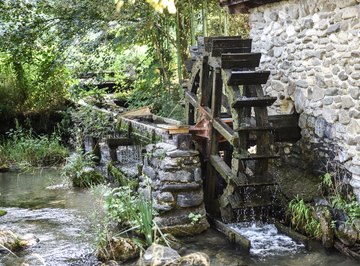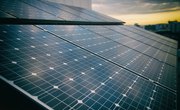
Moving water is an important source of energy, and people have harnessed that energy throughout the ages by building waterwheels.
They were common in Europe throughout the Middle Ages and were used to, among other things, crush rock, operate bellows for metal refineries and hammer flax leaves to turn them into paper. Waterwheels that milled grain were known as watermills, and because this function was so ubiquitous, the two words became more or less synonymous.
Michael Faraday's discovery of electromagnetic induction paved the way for the invention of the induction generator that eventually came to supply the entire world with electricity. An induction generator converts mechanical energy into electrical energy, and moving water is a cheap and abundant source of mechanical energy. It was natural, therefore, to adapt watermills into hydroelectric power generators.
To understand how a water wheel generator works, it helps to understand the principles of electromagnetic induction. Once you do, you might try building your own mini water wheel generator, using the motor from a small electric fan or other appliance.
The Principle of Electromagnetic Induction
Faraday (1791 - 1867) discovered induction by wrapping a conduction wire multiple times around a cylindrical core to make a solenoid. He connected the ends of the wires to a galvanometer, a device that measures current (and the precursor to the multimeter). When he moved a permanent magnet inside the solenoid, he found that the meter registered current.
Faraday noted that the current changed direction whenever he changed the direction he was moving the magnet, and the strength of the current depended on how fast he was moving the magnet.
These observations were later formulated into Faraday's Law, which relates E, the electromotive force (emf) in a conductor, also known as voltage, to the rate of change of magnetic flux ϕ experienced by the conductor. This relationship is usually written as follows:
N is the number of turns in the conductor coil. The symbol ∆ (delta) indicates a change in the quantity that follows it. The minus sign indicates that the direction of the electromotive force is opposite to the directions of the magnetic flux.
How Induction Works in an Electric Generator
Faraday's Law doesn't specify whether the coil or the magnet has to move to induce a current, and in fact it doesn't matter. One of them has to be moving, however, because the magnetic flux, which is the part of the magnetic field passing perpendicularly through the conductor, must be changing. No current is generated in a static magnetic field.
An induction generator usually has a spinning permanent magnet or a conducting coil magnetized by an external power source, called the rotor. It spins freely on a low-friction shaft (armature) inside a coil, which is called the stator, and when it spins, it generates a voltage in the stator coil.
The induced voltage changes direction cyclically with each spin of the rotor, so the resulting current also changes direction. It's known as alternating current (AC).
In a watermill, the energy to spin the rotor is supplied by moving water, and for simple ones, it's possible to use the generated electricity directly to power lights and appliances. More often, however, the generator is connected to the power grid and supplies power back to the grid.
In this scenario, the permanent magnet in the rotor is often replaced by an electromagnet, and the grid supplies AC current to magnetize it. To get a net output from the generator in this scenario, the rotor must spin an a frequency greater than that of the incoming power.
The Energy in Water
When harnessing water to do work, you're basically relying on the force of gravity, which is what makes water flow in the first place. The amount of energy you can derive from falling water depends on how much water is falling and how quickly. You'll get more energy per unit of water from a waterfall than you will from a flowing stream, and you'll obviously get more energy from a large stream or waterfall than you will from a small one.
In general, the energy available to do the work of turning the water wheel is given by mgh, where "m" is the mass of the water, "h" is the height through which it falls and "g" is the acceleration due to gravity. To maximize available energy, the water wheel should be at the bottom of the slope or waterfall, which maximizes the distance the water has to fall.
You don't have to measure the mass of the water flowing through the stream. All you have to do is estimate the volume. Because the density of water is a known quantity, and density is equal to mass divided by volume, it's easy to make the conversion.
Converting Water Power to Electricity
A water wheel converts the potential energy in a flowing stream or waterfall (mgh) into tangential kinetic energy at the point at which the water makes contact with the wheel. This generates rotational kinetic energy, given by I ω 2/2, where ω is the angular velocity of the wheel and I is the moment of inertia. The moment of inertia of a point rotating around a central axis is proportional to the square of the radius of rotation r: (I = mr2), where m is the mass of the point.
To optimize the conversion of energy, you want to maximize the angular velocity, ω, but to do that, you need to minimize I, which means minimizing the radius of rotation, r. A water wheel should have a small radius to ensure it spins fast enough to generate a net current. That leaves out the old windmills for which the Netherlands is famous. They are good for doing mechanical work, but not for generating electricity.
A Case Study: the Niagara Falls Hydroelectric Generator
One of the first large-scale water wheel induction generators, and the best known, came online at Niagara Falls, New York, in 1895. Conceived by Nikola Tesla and financed and designed by George Westinghouse, the Edward Dean Adams power station was the first of several plants to supply electricity to consumers in the United States.
The actual power plant is built about a mile upstream of Niagara Falls and gets water through a system of pipes. The water flows into a cylindrical housing in which is mounted a large water wheel. The force of the water spins the wheel, and it in turn spins the rotor of a larger generator to produce electricity.
The generator at the Adams power station uses 12 large permanent magnets, each of which produces a magnetic field of about 0.1 Tesla. They are attached to the generator's rotor and spin inside a large coil of wire. The generator produces about 13,000 volts, and to do this there must be at least 300 turns in the coil. About 4,000 amps of AC electricity courses through the coil when the generator is running.
The Environmental Impact of Hydroelectric Power
There are very few waterfalls in the world the size of Niagara Falls, which is why Niagara Falls is considered one of the world's natural wonders. Many hydroelectric generating stations are constructed on dams. Today, about 16 percent of the world's electricity is supplied by such hydroelectric stations, the largest of which are in China, Brazil, Canada, the United States and Russia. The largest plant is in China, but the one that produces the most electricity is in Brazil.
Once a dam has been built, there are no more costs associated with power generation. but there are some costs to the environment.
- Constructing a dam alters the flow of natural waterways, and this has an impact on the lives of plants, animals and humans who relied on the natural water flow. Construction of the Three Gorges Dam in China involved the relocation of 1.2 million people.
- Dams alter the natural life cycles of fish that live in the streams. In the Pacific Northwest, dams have deprived an estimated 40 percent of salmon and steelhead of their natural habitats.
- Water that comes from a dam has a reduced level of dissolved oxygen, and this affects fish, plants and wildlife that depend on the water.
- Hydropower production is affected by drought. When water runs low, it's often necessary to cease power production to preserve what water there is.
Scientists are looking at ways to mitigate the drawbacks of large power productions plants. One solution is to build systems of smaller ones that have less environmental impact. Another is to design intake valves and turbines to ensure that water released from the plant is properly oxygenated. Even with drawbacks, though, hydroelectric dams are among the cleanest, cheapest sources of electricity on the planet.
A Water Wheel Generator Science Project
A good way to help yourself understand the principles in hydroelectric power generation is to build a small electric generator yourself. You can do this with the motor from an inexpensive electric fan or other appliance. As long as the rotor inside the motor uses a permanent magnet, the motor can be used "in reverse" to generate electricity. The motor from a very old fan or appliance is a better candidate than a motor from a newer one, since older appliance motors are more likely to employ permanent magnets.
If you use a fan, you may be able to accomplish this project without even disassembling it, because the fan blades can act as the impellers. However, they aren't really designed for this, so you may want to cut them off and replace them with a more efficient water wheel that you construct yourself. Should you decide do this, you can use collar as a base for your improved water wheel, since it's already attached to the motor shaft.
To determine whether your mini water wheel generator is actually producing electricity, you'll have to connect a meter across the output coil. This is easy to do if you use an old fan or appliance, because it has a plug. Just connect the probes of a multimeter to the plug prongs and set the meter to measure AC voltage (VAC). If the motor you use doesn't have a plug, just connect the meter probes to the wires attached to the output coil, which in most cases are the only two wires you'll find.
You can use a natural source of falling water for this project or you can construct your own. The water falling from the spout of your bathtub should generate enough energy to produce a detectable current. If you're taking your project on the road to show other people, you may want to pour water from a pitcher or use a garden hose.
References
- Alternative Energy Tutorials: Induction Generator
- Michigan State University: Operation of Induction Generators
- For Teachers For Students: The Power of Water
- Georgia State University: Moment of Inertia
- Rochester Institute of Technology: The Niagara Falls Hydroelectric Station
- National Geographic: Hydropower, Explained
About the Author
Chris Deziel holds a Bachelor's degree in physics and a Master's degree in Humanities, He has taught science, math and English at the university level, both in his native Canada and in Japan. He began writing online in 2010, offering information in scientific, cultural and practical topics. His writing covers science, math and home improvement and design, as well as religion and the oriental healing arts.
